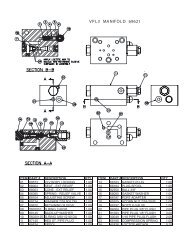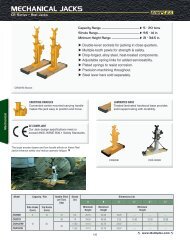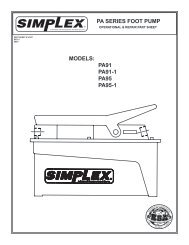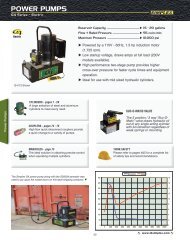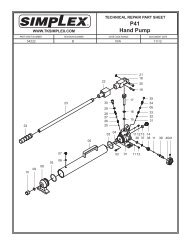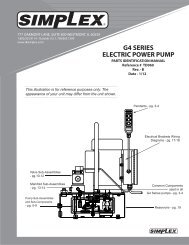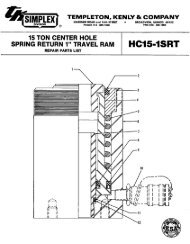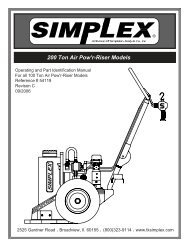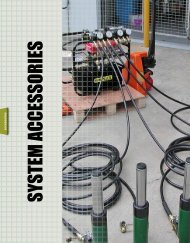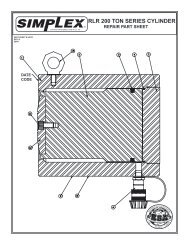please read and understand this manual before using ... - Simplex
please read and understand this manual before using ... - Simplex
please read and understand this manual before using ... - Simplex
Create successful ePaper yourself
Turn your PDF publications into a flip-book with our unique Google optimized e-Paper software.
Clean air bags after each use. Oil or grease spots can cause air bags to slide. Prolonged contact with<br />
petroleum-based liquids can also cause some types of rubber to degrade prematurely. The presence of<br />
dirt in the nozzle can cause leaks or prevent hose connection. In the upright position with the nozzle at<br />
the top, the air bag is to be knocked against the floor to shake off the dirt. Check the opening in the<br />
nozzle. If it is full of dirt, remove it <strong>using</strong> a thin piece of wire. Do not push the dirt inside the bag draw it<br />
out.<br />
To remove accumulated dirt or mud from the air bag surface, use a<br />
dry brush with hard bristles. Move the brush in all directions. Don't<br />
use sharp objects to remove dirt from the air bag surface. After<br />
cleaning all the agglutinated dirt, soak the spots with a light solution of<br />
warm water <strong>and</strong> a dish washing detergent, <strong>and</strong> <strong>using</strong> the brush,<br />
remove the remaining dirt (Figure 14).<br />
Figure 14<br />
Rinse the surface with cold, fresh water (Figure 15), Strong water jet<br />
shall remove all the dirt <strong>and</strong> detergent which might have remained on<br />
the air bag surface.<br />
With the air bag in the upright position, wipe the nozzle <strong>using</strong> a clean<br />
cloth. Let the air bag dry. Don't speed up drying by putting the air bag<br />
in a drier or close to a source of heat.<br />
Figure 15<br />
Inspection, storage <strong>and</strong> preventive maintenance<br />
Adequate maintenance <strong>and</strong> care for air bags require more than cleaning after use. Air bags call for<br />
inspection, <strong>and</strong> preventive maintenance throughout the period of storage.<br />
Check after use<br />
1. When dry, check the air bag for any blistering, cuts or worn out segments<br />
that might be hidden under the dirt. If you observe any deep cuts, damage or deep wear, mark it<br />
with a chalk, <strong>and</strong> consult the manufacturer or an authorized service.<br />
2. Check the nozzle for any wear or damage, which could hinder a positive connection or cause leaks.<br />
Replace the nozzle, if necessary.<br />
8 of 9




